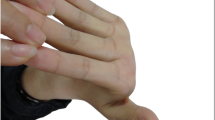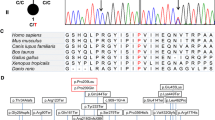Abstract
Mutations in SEPN1 cause selenoprotein N (SEPN)-related myopathy (SEPN-RM) characterized by early-onset axial and neck weakness, spinal rigidity, respiratory failure and histopathological features, ranging from mild dystrophic signs to a congenital myopathy pattern with myofibrillar disorganization. We report on clinical and instrumental features in three patients affected with a congenital myopathy characterized by prevalent neck weakness starting at different ages and mild myopathy, in whom we performed diagnosis of SEPN-RM. The patients presented myopathic signs since their first years of life, but the disease remained unrecognized because of a relatively benign myopathic course. In two cases, myopathic features were stable after 2 years of follow-up, but respiratory involvement worsened. The muscle MRI and muscle biopsy showed a typical pattern of SEPN-RM. Molecular diagnosis revealed two novel homozygous mutations in SEPN1, c.1176delA and c.726_727InsTCC.
Conclusion: This report underlines the clinical diagnostic clues of early neck and axial weakness to suspect a SEPN-RM and the usefulness of muscle MRI in conjunction with clinical features to achieve the diagnosis. Our data confirm the slow progression of respiratory involvement in spite of the relatively stable course of myopathy. We report two previously undescribed mutations in SEPN1.
What is known: • Mutations in SEPN1 cause myopathy characterized by early-onset axial and neck weakness spinal rigidity and respiratory failure. • SEPN-related myopathies have been initially associated with four distinct histopathological entities that however appear more mixed in recently described cases. |
What is New: • SEPN-related myopathies can remain unrecognized because of the normal early motor development and relatively benign myopathic course of the disease. • Our study adds two novel homozygous mutations to the number of reported pathogenic SEPN1 variants. |


Similar content being viewed by others
Abbreviations
- ALT:
-
Alanine aminotransferase
- AST:
-
Aspartate aminotransferase
- CK:
-
Creatine kinase
- LDH:
-
Lactate dehydrogenase
- MRI:
-
Magnetic resonance imaging
- NADH:
-
Dihydronicotinamide adenine dinucleotide dehydrogenase
- SEPN-RM:
-
SEPN-related myopathy
- VC:
-
Vital capacity
- WISC-R:
-
Wechsler Intelligence Scale for Children-Revised
References
Bianco F, Leone A, Pane M, Vasco G, Colosimo C, Mercuri E (2011) Muscle MRI: out of the tunnel. Neuromuscul Disord 21:501–502
Castets P, Lescure A, Guicheney P, Allamand V (2012) Selenoprotein N in skeletal muscle: from diseases to function. J Mol Med (Berl) 90:1095–1107
Clarke NF, Kidson W, Quijano-Roy S, Estournet B, Ferreiro A, Guicheney P, Manson JI, Kornberg AJ, Shield LK, North KN (2006) SEPN1: associated with congenital fibers type disproportion and insulin resistance. Ann Neurol 59:546–552
D’Amico A, Haliloglu G, Richard P, Talim B, Maugenre S, Ferreiro A, Guicheney P, Menditto I, Benedetti S, Bertini E, Bonne G, Topaloglu H (2005) Two patients with 'Dropped head syndrome' due to mutations in LMNA or SEPN1 genes. Neuromuscul Disord 15:521–524
Ferreiro A, Quijano-Roy S, Pichereau C, Moghadaszadeh B, Goemans N, Bönnemann C, Jungbluth H, Straub V, Villanova M, Leroy JP, Romero NB, Martin JJ, Muntoni F, Voit T, Estournet B, Richard P, Fardeau M, Guicheney P (2002) Mutations of the selenoprotein N gene, which is implicated in rigid spine muscular dystrophy, cause the classical phenotype of multiminicore disease: reassessing the nosology of early-onset myopathies. Am J Hum Genet 71:739–749
Ferreiro A, Ceuterick-de Groote C, Marks JJ, Goemans N, Schreiber G, Hanefeld F, Fardeau M, Martin JJ, Goebel HH, Richard P, Guicheney P, Bönnemann CG (2004) Desmin-related myopathy with Mallory body-like inclusions is caused by mutations of the selenoprotein N gene. Ann Neurol 55:676–686
Hankiewicz K, Carlier RY, Lazaro L, Linzoain J, Barnerias C, Gómez-Andrés D, Avila-Smirnow D, Ferreiro A, Estournet B, Guicheney P, Germain DP, Richard P, Bulacio S, Mompoint D, Quijano-Roy S (2015) Whole-body muscle magnetic resonance imaging in SEPN1-related myopathy shows a homogeneous and recognizable pattern. Muscle Nerve 52:728–735
Jungbluth H, Sewry CA, Brown SC, Nowak KJ, Laing NG, Wallgren-Pettersson C, Pelin K, Manzur AY, Mercuri E, Dubowitz V, Muntoni F (2001) Mild phenotype of nemaline myopathy with sleep hypoventilation due to a mutation in the skeletal muscle α-actin (ACTA1) gene. Neuromuscul Disord 11:35–40
Maiti B, Arbogast S, Allamand V, Moyle M, Anderson C, Richard P, Guicheney P, Ferreiro A, Flanigan K, Howard M (2009) Mutation in the SEPN1 SRE reduces selenocysteine incorporation and leads to SEPN1-related myopathy. Hum Mutat 30:411–416
Melià MJ, Kubota A, Ortolano S, Vílchez JJ, Gámez J, Tanji K, Bonilla E, Palenzuela L, Fernández-Cadenas I, Pristoupilová A, García-Arumí E, Andreu AL, Navarro C, Hirano M, Martí R (2013) Limb-girdle muscular dystrophy 1F is caused by a microdeletion in the transportin 3 gene. Brain 136:1508–1517
Mercuri E, Clements E, Offiah A, Pichiecchio A, Vasco G, Bianco F, Berardinelli A, Manzur A, Pane M, Messina S, Gualandi F, Ricci E, Rutherford M, Muntoni F (2010) Muscle magnetic resonance imaging involvement in muscular dystrophies with rigidity of the spine. Ann Neurol 67:201–208
Moghadaszadeh B, Petit N, Jaillard C, Brockington M, Quijano Roy S, Merlini L, Romero N, Estournet B, Desguerre I, Chaigne D, Muntoni F, Topaloglu H, Guicheney P (2001) Mutations in SEPN1 cause congenital muscular dystrophy with spinal rigidity and restrictive respiratory syndrome. Nat Genet 29:17–18
Quijano-Roy S, Carlier RY, Fischer D (2011) Muscle imaging in congenital myopathies. Semin Pediatr Neurol 18:221–229
Scoto M, Cirak S, Mein R, Feng L, Manzur AY, Robb S, Childs AM, Quinlivan RM, Roper H, Jones DH, Longman C, Chow G, Pane M, Main M, Hanna MG, Bushby K, Sewry C, Abbs S, Mercuri E, Muntoni F (2011) SEPN1-related myopathies: clinical course in a large cohort of patients. Neurology 76:2073–2078
Author information
Authors and Affiliations
Corresponding author
Ethics declarations
Funding
The study was supported by the Italian Telethon (grants no. GUP 11001 “Development of a registry and a database for a nation-wide Italian collaborative network on congenital muscular dystrophy” to IM). The EuroBioBank and Telethon Network of Genetic Biobanks (GTB12001F to MM) are gratefully acknowledged for providing the biological samples.
Conflict of interest
The authors declare that they have no competing interests.
Ethical approval
All procedures performed in studies involving human participants were in accordance with the ethical standards of the institutional and national research committee and with the 1964 Helsinki Declaration and its later amendments or comparable ethical standards.
Consent
Parental written informed consent was obtained for muscle biopsy, genetic analysis and any images in the paper. A copy of the written consent is available for review by the Editor of this journal.
Authors’ contributions
AA, CB, MM and IM conceived and designed the experiments and wrote the manuscript. CB carried out the molecular analysis. FB and FS performed the immunochemical evaluation of muscle biopsies and prepared the figures. EM performed muscle MRI. LM performed muscle biopsy and histological evaluation and critically revised the manuscript. AA, CG and IM performed clinical studies. All authors read and approved the final manuscript.
Additional information
Communicated by Mario Bianchetti
Electronic supplementary material
Below is the link to the electronic supplementary material.
ESM 1
The table is a supplementary data and reported clinical and instrumental features of patients (DOCX 19 kb)
Rights and permissions
About this article
Cite this article
Ardissone, A., Bragato, C., Blasevich, F. et al. SEPN1-related myopathy in three patients: novel mutations and diagnostic clues. Eur J Pediatr 175, 1113–1118 (2016). https://doi.org/10.1007/s00431-015-2685-3
Received:
Revised:
Accepted:
Published:
Issue Date:
DOI: https://doi.org/10.1007/s00431-015-2685-3




